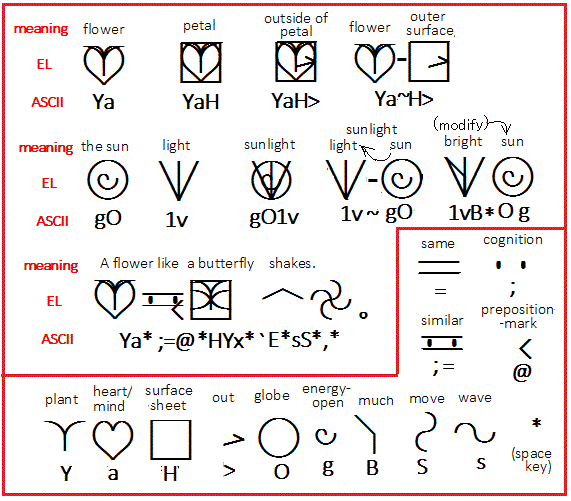 : Working as hyphen,
exceptionally this doesn't compound with any other symbols.
: Working as hyphen,
exceptionally this doesn't compound with any other symbols.This has only 1/4 of the frame width.
(左右の文字がともに一つの概念を表すことを示すつなぎ記号。英語のハイフンに相当し、これのみが1/4幅。他の記号とは重 ねられない。)
gf  : Working as hyphen,
exceptionally this doesn't compound with any other symbols.
: Working as hyphen,
exceptionally this doesn't compound with any other symbols.
This has only 1/4 of the frame width.
(左右の文字がともに一つの概念を表すことを示すつなぎ記号。英語のハイフンに相当し、これのみが1/4幅。他の記号とは重
ねられない。)
** This notation is renewed from ![]() (symbolized
piling of the both sides symbols.) by help of Jo Chen (German) on
September 1st, 2007. The new notation saves typing space and looking
easier, similarly to traditional hyphen.
(symbolized
piling of the both sides symbols.) by help of Jo Chen (German) on
September 1st, 2007. The new notation saves typing space and looking
easier, similarly to traditional hyphen.
hand-sign for #gf  :
:
( Four fingers are wrapping the thumb, making a fist)
日本語解説
It works for the glue, representing that the former sign and the next sign are inASCII : ~ (to indicate the relation that the both sides of this mark are connected together)
one base overlay. The readers combine the images in their heads.
In a hand sign conversation, one can not always use the both hand. To sign a complicate
base overlay by one hand, the EL hand sign needs more 'glue' than the regular writing.
name: ![]()
![]() [n@](@: schwa
without stress accent) 日本語解説
[n@](@: schwa
without stress accent) 日本語解説
definition (grammar) changed Feb. 2018:The EL vocal expression is basically by pronouncing base-names; and base overlays can not be
expressed by a syllable. It is as same as typing ASCII with a voice. Also you have to insert [space]
and [a half space] with voice to send a sentence.
At that time, it is not easy to integrate a complicate base overlay with a lot of syllables
just in the listener's imagination.
This glue-sound works to tell that the former base syllable and the next one are compounded
into a base overlay character. So you can express by separating a complicate base overlay into
elemental base-overlays/bases, while connecting them with this [n@] sound.
* Now the one-syllable-name of the base is tentative.
But once it could set up, it might be better to fix the sequence of bases pronunciation
of an elemental base-overlay, taking care of not to make a liaison, and for taking the meaning easier.
e.g.( I ) must be read as two syllables { [mw] for
+ [o] for
};
and the pronunciation in this sequence could easily be shortened into one syllable [mwo].
So fix the sound into [omw]. Following this way,(you): [oma],
(she): [osw],
(he): [ose]
It is similar to hyphen to connect the former character and. 動詞符 . 動詞符の重 ね文字
the next character together as one concept which sometimes can be shown as one base overlay.
For names of tools and classifications of things in nature, the base overlays could be complicated.
The hyphen (gf) helps to show elements of a concept separately with simpler characters.
Examples of the hyphen usage and ASCII, also an EL sentence in ASCII

When you can't use an EL overlay typing tool, or when you have to send a message
by sound or one hand sign, you send it by the base number or ASCII.
An ASCII message for a word, a phrase or a sentence is just the same as
the normal EL typing, but only thing you need * (asterisk which does nothing as an EL base)
to show the spot of [space key].
Because EL [space key] has an important function to command the typing spot to go next,
otherwise all bases can be typed at the same spot.
When you can't use the overlay system, you need to distinguish between bases and a base overlay.
So type * for the [space key] position to show how single words are lining.
In an EL phrase, the left character modifies the right one, unless including a grammatical mark
to change that order. But for showing elements of a base overlay with the hyphen,
the main element at the top would be more easily understood.
About word order in EL
Several times I got opinions/questions about why EL doesn't take fixed word order as subject-verb-object; and why the main character comes first and its modifiers follow. I know it is rational saving grammatical marks. But EL respects variety of cultures and expression stiles; and besides it's easier to make signs with one's own mother tongue. So keeping the free word-order is important for EL. The main concept is not always the most important in a sentence. In many cases, modifier is more important than the main noun. e.g. When saying pointing a flower, "the red flower I like the best," red is more important to take the order of priority than flower. Because the other knows it's about a flower. If setting a fixed word order, you have to feel like expressing in a mathematical formula forgetting nature of emotion.